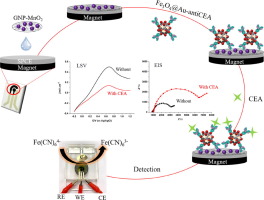当前位置:
X-MOL 学术
›
Bioelectrochemistry
›
论文详情
Our official English website, www.x-mol.net, welcomes your feedback! (Note: you will need to create a separate account there.)
An ultrasensitive immunosensor based on manganese dioxide-graphene nanoplatelets and core shell Fe3O4@Au nanoparticles for label-free detection of carcinoembryonic antigen.
Bioelectrochemistry ( IF 5 ) Pub Date : 2020-01-02 , DOI: 10.1016/j.bioelechem.2019.107452 Preeyanut Butmee 1 , Gamolwan Tumcharern 2 , Gerald Thouand 3 , Kurt Kalcher 4 , Anchalee Samphao 5
Bioelectrochemistry ( IF 5 ) Pub Date : 2020-01-02 , DOI: 10.1016/j.bioelechem.2019.107452 Preeyanut Butmee 1 , Gamolwan Tumcharern 2 , Gerald Thouand 3 , Kurt Kalcher 4 , Anchalee Samphao 5
Affiliation

|
A novel electrochemical immunosensor was developed for label-free detection of carcinoembryonic antigen (CEA) as a cancer biomarker. The designed immunosensor was based on CEA antibody (anti-CEA) anchored with core shell Fe3O4@Au nanoparticles which were immobilized on a screen-printed carbon electrode modified with manganese dioxide decorating on graphene nanoplatelets (SPCE/GNP-MnO2/Fe3O4@Au-antiCEA). The SPCE was placed onto a home-made electrode holder for easy handling. The approach was based on direct binding of CEA to a fixed amount of anti-CEA on the modified electrode for the specific detection using linear sweep voltammetry (LSV) and electrochemical impedance spectroscopy (EIS) monitored in a solution containing 5 mM [Fe(CN)63-/4-] prepared in 0.1 M phosphate buffer at pH 7.4. The difference in signal response owing to the redox reaction of [Fe(CN)6]3-/4- before and after interaction with CEA was regarded as the immunosensor response corresponding directly to the CEA concentration. Under optimized conditions, the linear range of 0.001-100 ng/mL, and the detection limits of 0.10 pg/mL (LSV) and 0.30 pg/mL (EIS) were evaluated. The applicability of the immunosensor was verified by well-corresponding determination of CEA in diluted human serum samples by electrochemiluminescence (ECL) immunoassay. Therefore, the proposed immunosensor could be suitable enough for a real sample analysis of CEA.
中文翻译:

基于二氧化锰-石墨烯纳米片和核壳Fe3O4 @ Au纳米粒子的超灵敏免疫传感器,用于无标记的癌胚抗原检测。
开发了一种新型的电化学免疫传感器,用于无标记地检测癌胚抗原(CEA)作为癌症的生物标志物。设计的免疫传感器基于CEA抗体(抗CEA),该抗体锚固在核壳Fe3O4 @ Au纳米颗粒上,该纳米颗粒被固定在用二氧化锰修饰的丝网印刷碳电极上,修饰在石墨烯纳米血小板上(SPCE / GNP-MnO2 / Fe3O4 @ Au- antiCEA)。将SPCE放置在自制的电极支架上,以便于操作。该方法基于修饰电极上CEA与固定量抗CEA的直接结合,用于使用线性扫描伏安法(LSV)和电化学阻抗谱(EIS)在含5 mM [Fe(CN在pH 7.4的0.1 M磷酸盐缓冲液中制备的[63- [4-]]。与CEA相互作用之前和之后,由于[Fe(CN)6] 3- / 4-的氧化还原反应导致的信号响应差异被视为直接对应于CEA浓度的免疫传感器响应。在优化的条件下,评估的线性范围为0.001-100 ng / mL,检出限为0.10 pg / mL(LSV)和0.30 pg / mL(EIS)。通过电化学发光(ECL)免疫测定法很好地确定了稀释的人血清样品中的CEA,从而验证了免疫传感器的适用性。因此,提出的免疫传感器可能足够适合于CEA的真实样品分析。检出限分别为0.10 pg / mL(LSV)和0.30 pg / mL(EIS)。通过电化学发光(ECL)免疫测定法很好地确定了稀释的人血清样品中的CEA,从而验证了免疫传感器的适用性。因此,提出的免疫传感器可能足够适合于CEA的真实样品分析。检出限分别为0.10 pg / mL(LSV)和0.30 pg / mL(EIS)。通过电化学发光(ECL)免疫测定法很好地确定了稀释的人血清样品中的CEA,从而验证了免疫传感器的适用性。因此,提出的免疫传感器可能足够适合于CEA的真实样品分析。
更新日期:2020-01-02
中文翻译:

基于二氧化锰-石墨烯纳米片和核壳Fe3O4 @ Au纳米粒子的超灵敏免疫传感器,用于无标记的癌胚抗原检测。
开发了一种新型的电化学免疫传感器,用于无标记地检测癌胚抗原(CEA)作为癌症的生物标志物。设计的免疫传感器基于CEA抗体(抗CEA),该抗体锚固在核壳Fe3O4 @ Au纳米颗粒上,该纳米颗粒被固定在用二氧化锰修饰的丝网印刷碳电极上,修饰在石墨烯纳米血小板上(SPCE / GNP-MnO2 / Fe3O4 @ Au- antiCEA)。将SPCE放置在自制的电极支架上,以便于操作。该方法基于修饰电极上CEA与固定量抗CEA的直接结合,用于使用线性扫描伏安法(LSV)和电化学阻抗谱(EIS)在含5 mM [Fe(CN在pH 7.4的0.1 M磷酸盐缓冲液中制备的[63- [4-]]。与CEA相互作用之前和之后,由于[Fe(CN)6] 3- / 4-的氧化还原反应导致的信号响应差异被视为直接对应于CEA浓度的免疫传感器响应。在优化的条件下,评估的线性范围为0.001-100 ng / mL,检出限为0.10 pg / mL(LSV)和0.30 pg / mL(EIS)。通过电化学发光(ECL)免疫测定法很好地确定了稀释的人血清样品中的CEA,从而验证了免疫传感器的适用性。因此,提出的免疫传感器可能足够适合于CEA的真实样品分析。检出限分别为0.10 pg / mL(LSV)和0.30 pg / mL(EIS)。通过电化学发光(ECL)免疫测定法很好地确定了稀释的人血清样品中的CEA,从而验证了免疫传感器的适用性。因此,提出的免疫传感器可能足够适合于CEA的真实样品分析。检出限分别为0.10 pg / mL(LSV)和0.30 pg / mL(EIS)。通过电化学发光(ECL)免疫测定法很好地确定了稀释的人血清样品中的CEA,从而验证了免疫传感器的适用性。因此,提出的免疫传感器可能足够适合于CEA的真实样品分析。


























 京公网安备 11010802027423号
京公网安备 11010802027423号